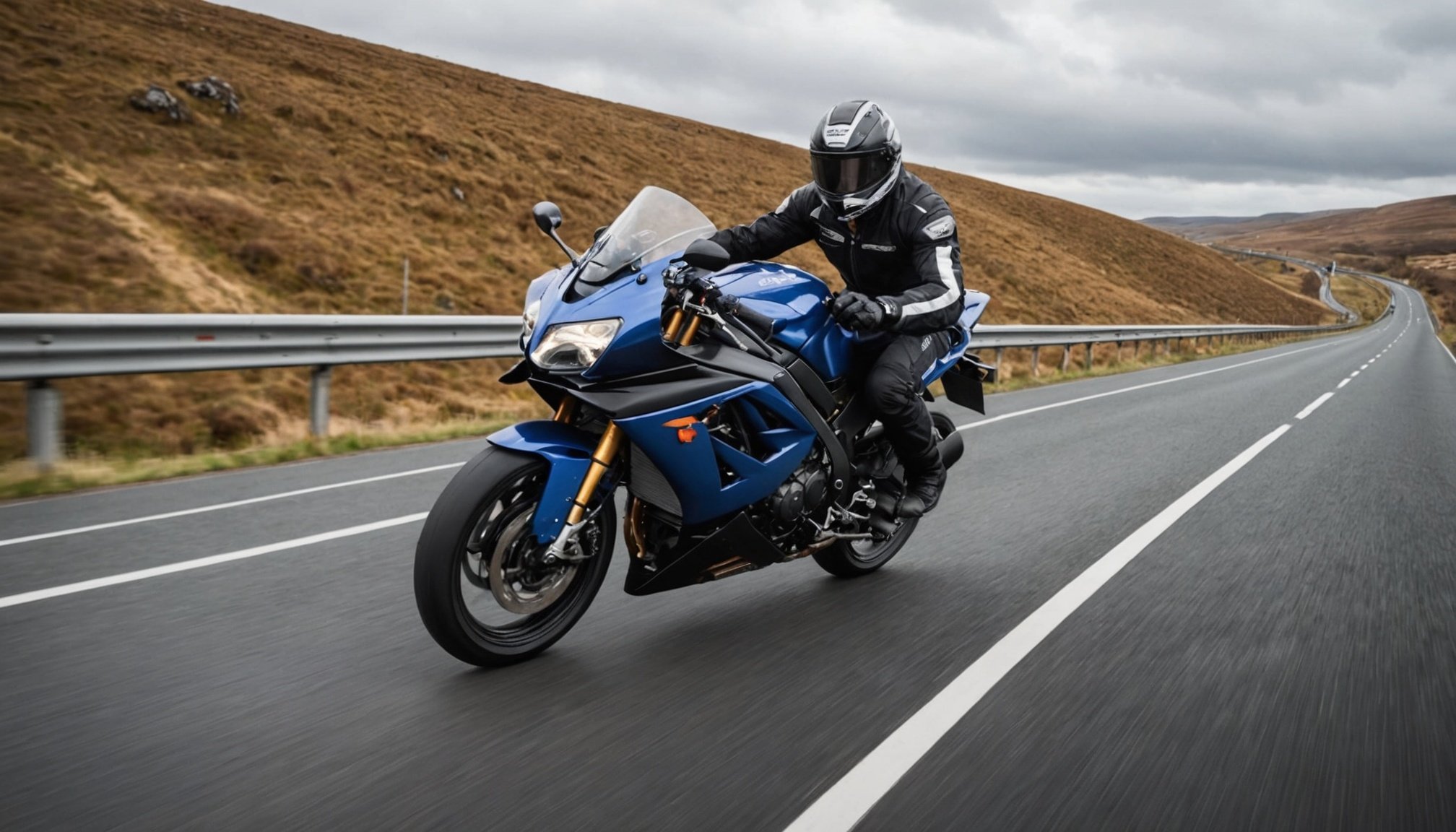Understanding High Winds and Their Impact on Sport Bikes
High winds present unique challenges for sport bike handling, often affecting motorcycle stability. Riders may wonder, “How do high winds impact a motorcycle’s stability?” High winds can disrupt a motorcycle’s balance and cause it to drift off course, increasing rider fatigue and risk of accidents.
In the UK, certain bridge locations are notorious for challenging wind factors. Bridges typically span open areas, like rivers or valleys, where winds can become particularly fierce. These conditions demand that motorcyclists remain vigilant about wind patterns. Riders should be informed: “Why is understanding wind patterns before riding important?” It’s crucial because being aware of changing wind factors allows riders to anticipate and adjust their riding techniques in real-time, enhancing safety and confidence.
This might interest you : Unlocking peak performance: the best engine setups for sport bikes in uk weather conditions
To navigate high wind regions safely, especially on bridges, assessing wind patterns through weather forecasts can be crucial. Consider the local geography and historical wind data, which are often available through weather services or community forums. Thus, developing strategies to deal with such conditions is essential for all sport bike riders. Conquering bridge navigation strategies under high winds requires foresight and preparation, ensuring each journey is a safe one.
Techniques for Riding in Windy Conditions
Confronting challenging weather on a sport bike necessitates mastering specific riding techniques. One critical aspect is managing wind resistance through proper body positioning. By lowering the body and hugging the bike, riders decrease the surface area exposed to wind gusts, aiding in maintaining stability. Imagine a sailboat without a sail—by creating less wind resistance, the rider achieves smoother navigation through the bluster.
Additional reading : Comprehensive toolkit for diy sport bike maintenance in the uk: your essential guide
Adjusting speed and throttle control in high winds is also essential for maintaining control. Riders should moderate their speed to ensure they have adequate time to react to sudden gusts. This approach not only enhances safety but provides a cushion against unpredictable conditions. On particularly blustery days, throttle control should be gentle yet precise, allowing for subtle changes in velocity without risking imbalance.
Facing gusts, riders must employ techniques that enable them to stay in command of their sports bike. This can range from shifting weight appropriately to counteracting wind push to steering into the wind slightly to maintain course. Such techniques, once mastered, allow for a more confident riding experience, even under less-than-ideal weather conditions, ultimately fostering a sense of assurance on the road.
Navigating UK Bridges: Key Considerations
UK bridges pose significant challenges for motorcyclists due to their exposure to high winds. Identifying these problematic structures is crucial for ensuring safe passage. Bridges like the Severn and Humber, known for spanning expansive open areas, become wind tunnels for unsuspecting riders. The narrow lanes and elevation can further amplify wind effects, demanding heightened alertness.
When approaching such bridges, employing specific bridge navigation tips can be a lifesaver. Before crossing, check local weather alerts for wind speeds and direction. Understanding these factors aids in anticipating potential movement during the ride, thereby reducing surprises. Adjusting speed appropriately, as with general windy conditions, is vital; lower speeds offer more time for reaction and adjustment.
Managing sudden wind changes while on a bridge involves maintaining a firm but flexible grip. Stay relaxed in your posture to allow the motorcycle to naturally right itself when faced with gusts. Angle yourself slightly against the wind to maintain course without overcorrecting, which could lead to instability.
Incorporate these motorcycle safety strategies into your rides over UK bridges to enhance confidence and control. Awareness of the environment and proactive measures can mitigate the risks posed by these wind-prone thoroughfares.
Essential Safety Gear for High Wind Riding
When venturing out on your sport bike, especially in high wind conditions, selecting the right motorcycle gear is vital for both safety and comfort. Consider jackets and pants crafted from wind-resistant materials. These not only shield you from storms but also reduce wind drag, enhancing control and stability.
Helmets play an indispensable role in maintaining safety amongst windy challenges. Opt for sleek designs that reduce air resistance, equipped with visor systems to minimize wind noise and vibration. A helmet ensures that your head remains stable, decreasing fatigue and maintaining focus on navigation.
Additional gear can substantially boost your riding experience in blustery conditions. Investing in gloves with good grip aids in keeping a firm hold on the handlebars. Consider wearing boots designed for solid traction to prevent slippage when stopping or maneuvering. Layering with thermal wear can guard against low temperatures, keeping you comfortable despite the wind chill.
Riders should prioritize protective clothing as integral to their riding strategy. By integrating these elements, you create a buffer against winds, enhancing stability. This approach ensures your journey is both safe and pleasurable, empowering you to focus more on the thrill of the ride rather than battling the elements.
Weather Forecasting and Planning Your Ride
Incorporating weather forecasting into your motorcycle preparations is essential for ensuring a safe journey in unpredictable conditions. Before heading out on your expedition, utilise reliable weather apps to check for wind speeds and direction. These tools offer real-time updates that can alert you to any changes in the weather, allowing you to adjust your plans accordingly.
Understanding aviation reports like METARs and TAFs can offer deeper insights into current and future weather patterns. These reports, though primarily designed for pilots, provide precise details on wind conditions that impact riding safety. Such information helps determine if you should proceed with or postpone your ride, ensuring you avoid hazardous conditions.
When planning your route, aim to avoid areas known for high winds or adverse weather. Familiarise yourself with the local geography and choose roads that offer some protection against blustery elements. By planning your journey carefully, you can minimise exposure to risky sections and enhance overall riding safety.
By factoring riding safety and weather into your plans, you set the stage for a stress-free and enjoyable experience. Proactive measures in trip planning ensure that you remain in control, ready to face any weather challenges that come your way.
Personal Anecdotes and Expert Opinions on Riding in Wind
Riding in high wind conditions can be daunting, but hearing from those who’ve faced such challenges offers invaluable insights. Seasoned riders often share their experiences tackling gusty weather. Take John, a veteran rider who recalls crossing the Severn Bridge under heavy winds: “Lean into the wind, but never fight it entirely. Allow the bike some natural give.” His tale underscores the balance between control and adaptability crucial for motorcycle safety.
Engaging with expert opinions, many pro-riders advocate for honing skills specifically for windy situations. Katherine Reid, a motorcycling instructor, highlights the significance of riding techniques: “Mastering weight distribution and throttle control primarily can turn a potential hazard into a manageable ride.” Her advice complements practical safety tips for motorcyclists.
Within the motorcycling community, advice threads and forums abound with wind navigation tips. One popular recommendation emphasizes planning. Riders often suggest checking local weather forecasts multiple times pre-ride to anticipate conditions accurately. “Plan, predict, and prepare,” a mantra echoed by many community enthusiasts, encapsulates their collective wisdom. Engaging with these narratives helps both new and experienced riders refine their approaches, blending personal stories with tested strategies for safer journeys in the wind.











